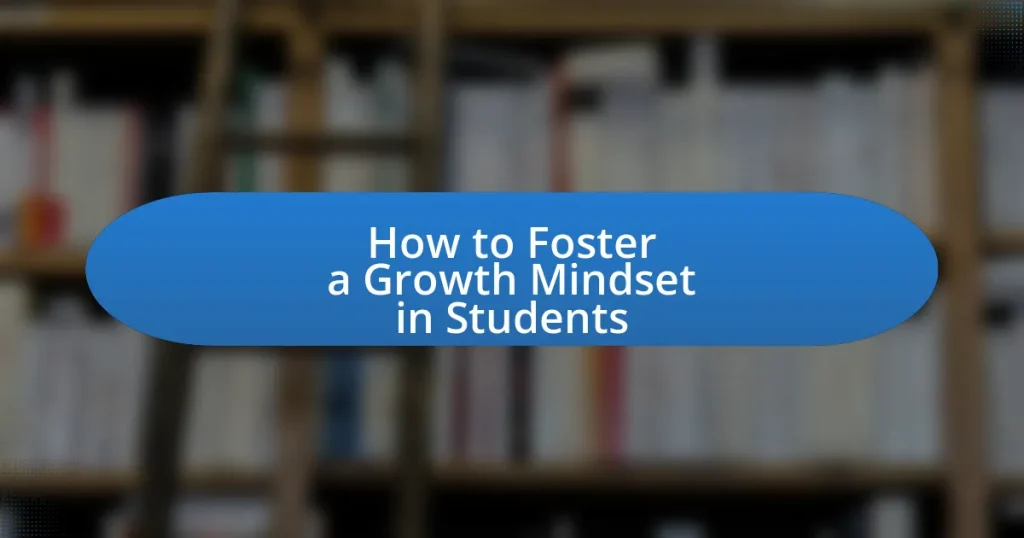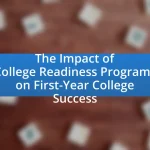A Growth Mindset is the belief that abilities and intelligence can be developed through dedication and hard work, as introduced by psychologist Carol Dweck. This article explores the differences between a Growth Mindset and a Fixed Mindset, highlighting the key characteristics and benefits of fostering a Growth Mindset in students, such as improved academic performance and emotional resilience. It also discusses effective teaching strategies, the role of classroom environments, and practical tips for educators to encourage a Growth Mindset, while addressing potential challenges and providing resources for implementation.
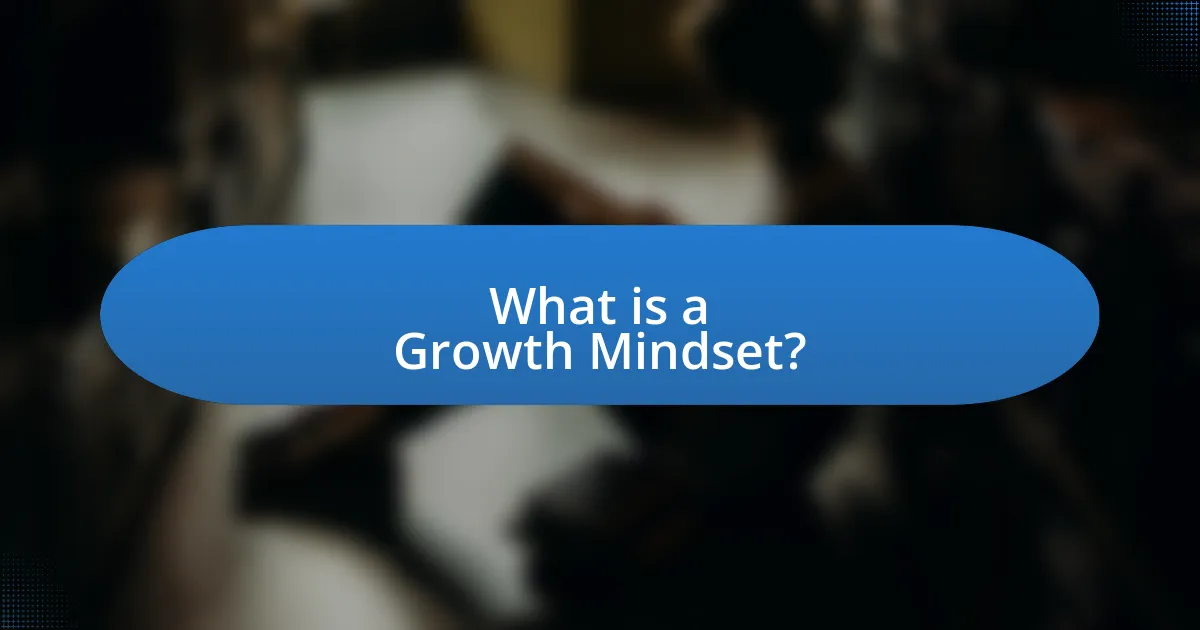
What is a Growth Mindset?
A growth mindset is the belief that abilities and intelligence can be developed through dedication and hard work. This concept, introduced by psychologist Carol Dweck, emphasizes the importance of perseverance and learning from failures. Research shows that individuals with a growth mindset are more likely to embrace challenges, persist in the face of setbacks, and view effort as a path to mastery, leading to greater achievement and personal development.
How does a Growth Mindset differ from a Fixed Mindset?
A Growth Mindset differs from a Fixed Mindset in that individuals with a Growth Mindset believe their abilities and intelligence can be developed through effort and learning, while those with a Fixed Mindset view their abilities as static and unchangeable. Research by psychologist Carol Dweck indicates that people with a Growth Mindset are more likely to embrace challenges, persist in the face of setbacks, and see effort as a path to mastery, whereas individuals with a Fixed Mindset may avoid challenges, give up easily, and feel threatened by the success of others. This distinction is crucial in educational settings, as fostering a Growth Mindset can lead to improved academic performance and resilience among students.
What are the key characteristics of a Growth Mindset?
A Growth Mindset is characterized by the belief that abilities and intelligence can be developed through dedication and hard work. This perspective fosters a love for learning and resilience, essential for great accomplishments. Individuals with a Growth Mindset embrace challenges, persist in the face of setbacks, see effort as a path to mastery, learn from criticism, and find inspiration in others’ success. Research by Carol Dweck, a psychologist at Stanford University, supports these characteristics, demonstrating that students with a Growth Mindset achieve higher academic performance and are more likely to take on challenging tasks.
Why is understanding mindsets important for students?
Understanding mindsets is important for students because it directly influences their motivation, learning strategies, and resilience in the face of challenges. Research by Carol Dweck, a leading psychologist in this field, shows that students with a growth mindset—believing that abilities can be developed through effort—tend to achieve higher academic success compared to those with a fixed mindset, who believe their abilities are static. This understanding enables students to embrace challenges, persist through difficulties, and view failures as opportunities for growth, ultimately leading to improved educational outcomes and personal development.
What are the benefits of fostering a Growth Mindset in students?
Fostering a Growth Mindset in students enhances their resilience, motivation, and academic performance. Research indicates that students with a Growth Mindset are more likely to embrace challenges, persist through difficulties, and view failures as opportunities for learning. For instance, a study by Dweck (2006) found that students who believed their abilities could improve through effort achieved higher grades and demonstrated greater engagement in their learning processes. This mindset shift not only improves academic outcomes but also promotes lifelong learning and adaptability in various life situations.
How does a Growth Mindset impact academic performance?
A growth mindset positively impacts academic performance by fostering resilience, motivation, and a willingness to embrace challenges. Students with a growth mindset believe that their abilities can be developed through effort and learning, which leads to increased engagement in their studies. Research by Dweck (2006) indicates that students who adopt a growth mindset are more likely to persist in the face of difficulties, ultimately resulting in higher academic achievement. Furthermore, a study published in the Journal of Educational Psychology found that students with a growth mindset showed improved grades and test scores compared to their peers with a fixed mindset, demonstrating the tangible benefits of this perspective on academic success.
What role does a Growth Mindset play in emotional resilience?
A Growth Mindset significantly enhances emotional resilience by fostering a belief in the ability to learn and adapt through challenges. Individuals with a Growth Mindset view setbacks as opportunities for growth rather than insurmountable obstacles, which enables them to cope better with stress and adversity. Research by Dweck (2006) indicates that students who embrace a Growth Mindset are more likely to persist in the face of difficulties, leading to improved emotional regulation and resilience. This adaptability is crucial for managing emotions effectively, as it encourages proactive problem-solving and a positive outlook on challenges.
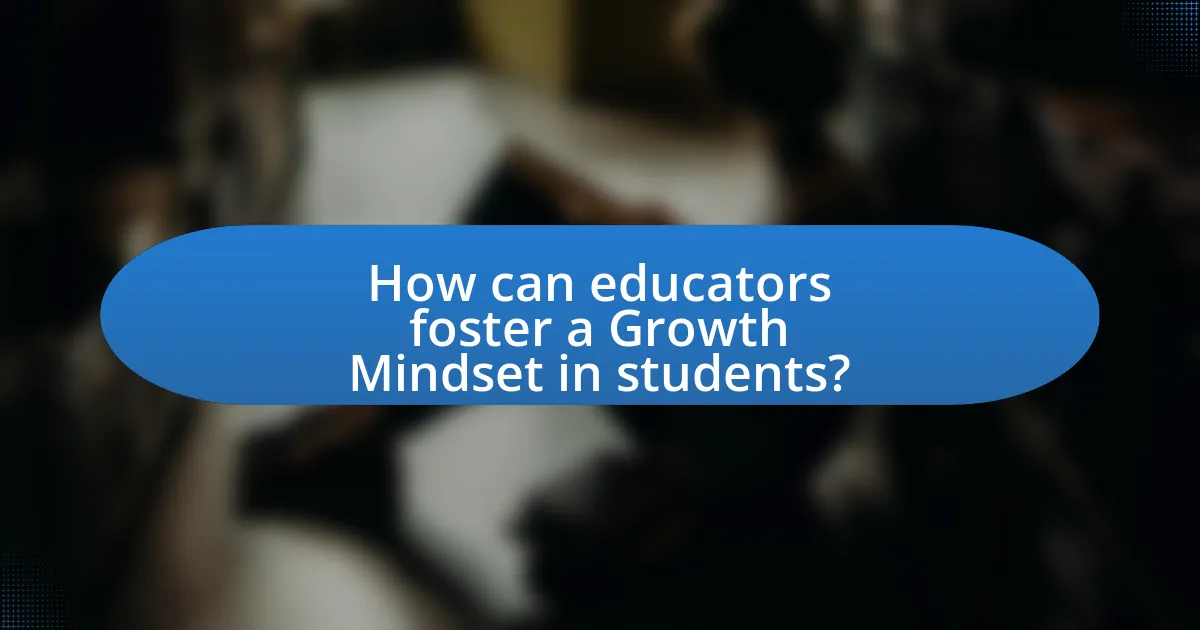
How can educators foster a Growth Mindset in students?
Educators can foster a Growth Mindset in students by encouraging a focus on effort, resilience, and learning from mistakes. This approach involves praising students for their hard work and persistence rather than their innate abilities, which research by Carol Dweck, a leading psychologist in this field, has shown to significantly impact students’ motivation and achievement. Dweck’s studies indicate that when students understand that their intelligence and abilities can be developed through dedication and effort, they are more likely to embrace challenges and persist in the face of setbacks. Additionally, educators can model a Growth Mindset by sharing their own learning experiences and emphasizing the value of feedback, thereby creating an environment where students feel safe to take risks and learn from failures.
What teaching strategies promote a Growth Mindset?
Teaching strategies that promote a Growth Mindset include encouraging effort over innate ability, providing constructive feedback, and fostering a safe environment for risk-taking. These strategies help students understand that intelligence and skills can be developed through dedication and hard work. Research by Carol Dweck, a leading psychologist in this field, demonstrates that students who are praised for their effort rather than their intelligence are more likely to embrace challenges and persist in the face of setbacks. This approach not only enhances learning but also builds resilience, as students learn to view failures as opportunities for growth.
How can feedback be used to encourage a Growth Mindset?
Feedback can be used to encourage a Growth Mindset by emphasizing effort, progress, and learning from mistakes. When feedback focuses on the process rather than the outcome, it reinforces the idea that abilities can be developed through dedication and hard work. Research by Dweck (2006) shows that students who receive process-oriented feedback are more likely to embrace challenges and persist in the face of setbacks, as they view failures as opportunities for growth rather than as reflections of their intelligence. This approach fosters resilience and a love for learning, essential components of a Growth Mindset.
What role does goal-setting play in developing a Growth Mindset?
Goal-setting plays a crucial role in developing a Growth Mindset by providing clear objectives that encourage persistence and resilience. When students set specific, measurable, achievable, relevant, and time-bound (SMART) goals, they create a roadmap for their learning journey, which fosters a sense of ownership and accountability. Research by Dweck (2006) indicates that individuals with a Growth Mindset view challenges as opportunities for growth, and goal-setting reinforces this perspective by helping them track progress and celebrate small victories. This process not only enhances motivation but also cultivates a belief in their ability to improve through effort and learning, essential components of a Growth Mindset.
How can classroom environment influence a Growth Mindset?
A classroom environment can significantly influence a growth mindset by promoting a culture of learning, resilience, and constructive feedback. When educators create a supportive atmosphere that encourages risk-taking and values effort over innate ability, students are more likely to embrace challenges and view failures as opportunities for growth. Research by Dweck (2006) highlights that environments fostering collaboration and open communication lead to increased motivation and a willingness to learn from mistakes. Additionally, classrooms that celebrate progress and provide specific, actionable feedback help students understand that intelligence and abilities can be developed, reinforcing the principles of a growth mindset.
What practices create a supportive learning atmosphere?
Practices that create a supportive learning atmosphere include fostering open communication, encouraging collaboration, and providing constructive feedback. Open communication allows students to express their thoughts and concerns, which builds trust and a sense of belonging. Encouraging collaboration among students promotes teamwork and enhances problem-solving skills, as evidenced by research showing that cooperative learning can improve academic performance (Johnson & Johnson, 2009). Providing constructive feedback helps students understand their strengths and areas for improvement, reinforcing a growth mindset by emphasizing effort and progress rather than innate ability.
How can collaboration among students enhance a Growth Mindset?
Collaboration among students enhances a Growth Mindset by fostering an environment where they can share ideas, learn from each other, and embrace challenges collectively. When students work together, they encounter diverse perspectives and problem-solving approaches, which encourages them to view difficulties as opportunities for growth rather than obstacles. Research by Johnson and Johnson (1994) indicates that cooperative learning strategies lead to higher achievement and greater motivation, reinforcing the belief that effort and persistence can lead to improvement. This collaborative process not only builds social skills but also instills resilience, as students support one another in overcoming setbacks, thereby solidifying a Growth Mindset.
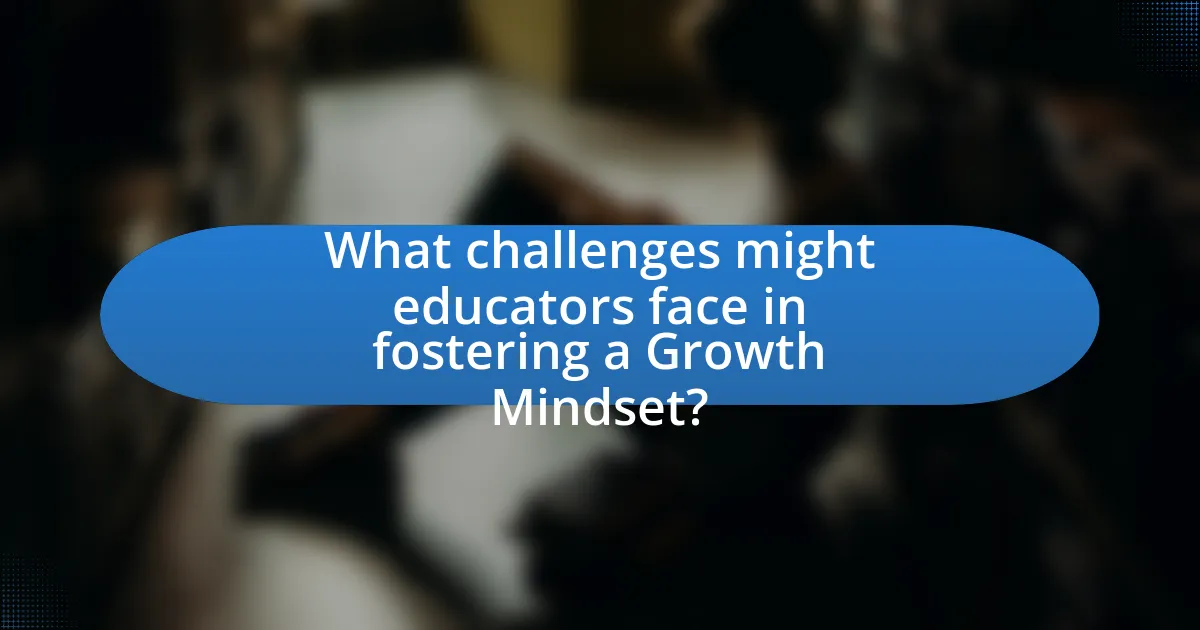
What challenges might educators face in fostering a Growth Mindset?
Educators may face several challenges in fostering a Growth Mindset, including resistance from students who are accustomed to a fixed mindset. This resistance can manifest as reluctance to embrace challenges or fear of failure, which hinders their willingness to learn and grow. Additionally, educators might struggle with a lack of resources or training on how to effectively teach and model Growth Mindset principles. Research indicates that teachers who are not adequately trained may find it difficult to implement strategies that promote resilience and perseverance in students. Furthermore, systemic issues such as standardized testing pressures can undermine efforts to cultivate a Growth Mindset, as these environments often prioritize immediate performance over long-term learning and development.
How can resistance to change be addressed?
Resistance to change can be addressed by fostering open communication and involving individuals in the change process. Engaging stakeholders in discussions about the reasons for change and the benefits it brings can reduce anxiety and build trust. Research indicates that organizations that prioritize transparent communication experience 70% higher employee engagement during transitions, as noted in a study by Kotter International. Additionally, providing training and support helps individuals develop the skills necessary to adapt, further mitigating resistance.
What strategies can help overcome student skepticism?
To overcome student skepticism, educators can implement strategies such as building trust through open communication, providing relevant real-world examples, and fostering a supportive classroom environment. Establishing trust encourages students to engage more openly with the material, while real-world examples demonstrate the practical application of concepts, making learning more relatable. A supportive environment allows students to express doubts without fear of judgment, which can lead to increased willingness to explore new ideas. Research indicates that when students feel safe and valued, their skepticism diminishes, leading to improved learning outcomes.
How can educators manage their own fixed mindset tendencies?
Educators can manage their own fixed mindset tendencies by actively engaging in self-reflection and adopting a growth mindset approach. Self-reflection allows educators to identify their limiting beliefs and recognize situations where they may feel challenged or threatened. By embracing challenges as opportunities for growth, educators can shift their perspective and model this behavior for their students. Research by Carol Dweck, a leading psychologist in the field of mindset, indicates that individuals who adopt a growth mindset are more resilient and open to learning from failures. This evidence supports the idea that educators can cultivate a growth mindset by seeking feedback, setting learning goals, and viewing effort as a pathway to mastery.
What resources are available to support the development of a Growth Mindset?
Resources available to support the development of a Growth Mindset include books, online courses, workshops, and educational programs. Notable books such as “Mindset: The New Psychology of Success” by Carol S. Dweck provide foundational knowledge on the concept of Growth Mindset. Online platforms like Coursera and edX offer courses specifically focused on developing a Growth Mindset, often featuring insights from educational experts. Workshops conducted by educational institutions or organizations like the Mindset Works provide practical strategies and activities to foster this mindset in students. Additionally, educational programs that integrate Growth Mindset principles into their curriculum can effectively support students in adopting this approach to learning.
What books and materials can educators use?
Educators can use books such as “Mindset: The New Psychology of Success” by Carol S. Dweck, which provides foundational insights into growth mindset principles. Additionally, “Grit: The Power of Passion and Perseverance” by Angela Duckworth offers strategies for developing resilience in students. Materials like the “Growth Mindset Toolkit” from the University of California, Berkeley, provide practical activities and resources for classroom implementation. Research indicates that these resources effectively promote a growth mindset, enhancing student motivation and achievement.
How can online platforms assist in fostering a Growth Mindset?
Online platforms can assist in fostering a Growth Mindset by providing access to resources that promote learning from challenges and failures. These platforms often feature interactive tools, such as quizzes and forums, that encourage students to engage with material actively, reinforcing the idea that effort leads to improvement. For instance, platforms like Khan Academy offer personalized learning experiences, allowing students to progress at their own pace and view mistakes as opportunities for growth. Research indicates that students who utilize such platforms demonstrate increased resilience and a willingness to embrace challenges, as highlighted in studies by Dweck (2006) on mindset theory.
What are practical tips for implementing a Growth Mindset in the classroom?
To implement a Growth Mindset in the classroom, educators should encourage students to embrace challenges, persist through difficulties, and view effort as a path to mastery. This can be achieved by incorporating activities that promote resilience, such as problem-solving tasks that require critical thinking and collaboration. Additionally, teachers can model a Growth Mindset by sharing their own learning experiences and emphasizing the value of feedback. Research by Dweck (2006) highlights that students who understand that abilities can be developed are more likely to take on challenges and improve their performance. By fostering an environment where mistakes are seen as learning opportunities, educators can significantly enhance students’ motivation and achievement.
